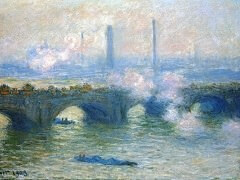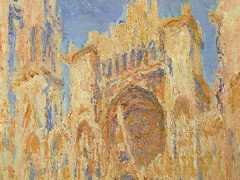Waterloo Bridge, Sunlight Effect, 1903 by Claude Monet

For his London paintings, Claude Monet would either start work on a new canvas immediately or return to one that had the beginnings of what he was witnessing. This practice accounts for the vast number of canvases that he started, many of which were never finished. There was an obvious area of tension between the disparity of being a painter of scenes of impressionistic immediacy and completing canvases in the studio.
Georges Seurat so wrote:
In his desire to paint the most complex effects of light, Monet seems to have attained the extreme limits of art... He wanted to explore the unexplorable, to express the inexpressible, to build, as the popular expression has it, on the fogs of the Thames! And worse still, he succeeded."
The ghostly picture Waterloo Bridge, Sunlight Effect is at once ethereal and grounded in the realism of the man-made bridge and chimney stacks. Monet has used a softer brushwork approach and blurred his paint to produce the foggy atmosphere, from which the bridge rises in illuminated grandeur. If not for the fog, Claude Monet once remarked,
London wouldn’t be a beautiful city. It’s the fog that gives it its magnificent breadth."




















